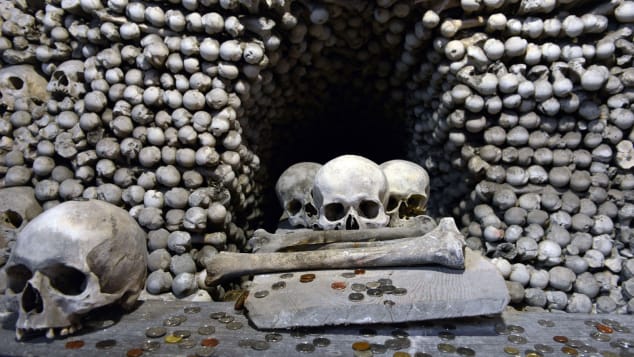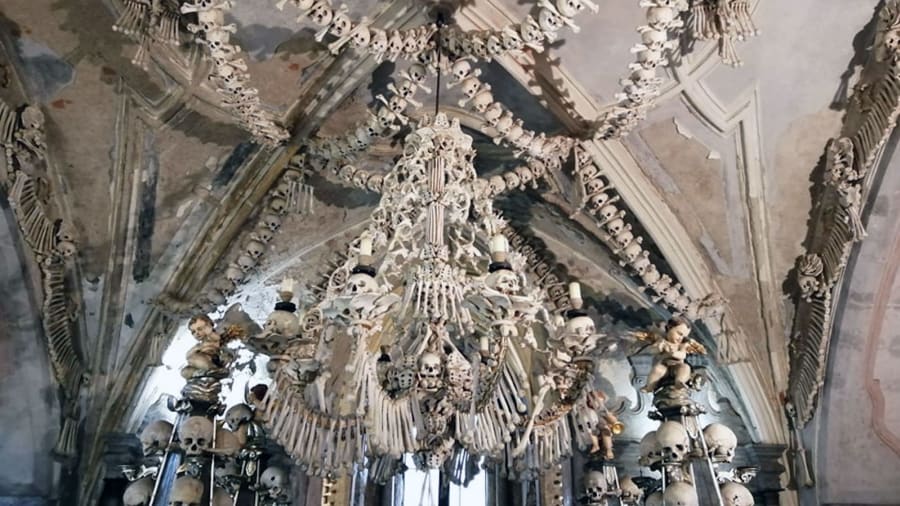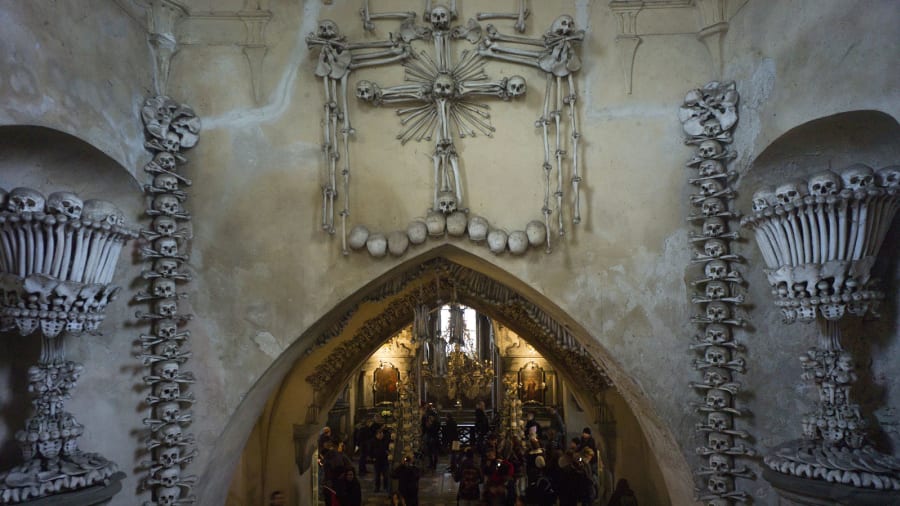Inside the Czech 'Church of Bones'
 |
Sedlec Ossuary is adorned with around 40,000 human skeletons. Photo: Michal Cizek/ Stringer/Getty Images
In the heart of the Czech countryside, Kutná Hora houses some of the most beautiful architecture in the whole of Bohemia.
Positioned around 70 kilometers (about 43 miles) east of Prague, this medieval city competed politically, economically and culturally with the capital city during the 13th to 16th centuries, thanks in part to the silver mine boom that enriched the area at the time.
Today, however, Kutná Hora displays a more sedate, yet impressive vision of Czech culture and tradition -- hence its UNESCO World Heritage Site status. But amid its Baroque-style buildings and medieval churches, lies an attraction that's definitely not for the faint-hearted traveler.
 |
It also contains an elaborate bone chandelier, as well as garlands of human skulls. Courtesy Sedlec Ossuary
Take a short walk through the narrow streets of the small suburb of Sedlec and you'll reach a quaint yet eerie chapel.
And while the Church of All Saints seems rather unassuming from the outside, lurking underneath is an enthralling tale of mystery and death.
Down a small staircase, in the lower chamber of this Roman Catholic church, lies the Sedlec Ossuary, which is adorned with around 40,000 human skeletons.
Dubbed the Church of Bones, the story behind this grisly attraction begins in 1278, when the King of Bohemia sent the abbot of the Sedlec Cistercian Monastery to Jerusalem.
He's said to have come back with a jar of soil from the Golgotha, the site where the crucifixion of Jesus Christ is said to have occurred, and spread it around the local cemetery.
When news of the "Holy Soil" became public, people from all over the region started requesting to be buried there.
The bones that currently reside in Sedlec Ossuary were exhumed from this site in the 15th century to make room for the town's expansion, as well as new burials.
They apparently lay stacked in the basement of this Gothic church until 1870, when a woodcarver named Frantisek Rint was appointed to excavate and organize them. The result is spectacularly shocking.
To the left of the chandelier, sits a coat of arms formed of the bones of the Schwarzenbergs, an aristocratic Czech family who once ruled over the city.
Meanwhile, a collection of human skulls piled on top of each other stands to the right.
Each is accompanied by religious displays arranged out of bone, reminding visitors that the chapel remains a respectful place of worship, despite its rather macabre contents.
 |
Not only is the ossuary part of a church, it's also surrounded by a functional cemetery. Photo: Michal Cizek/ Stringer/Getty Images
"There are still regular masses held in the upper chapel as well as in the lower chapel," explains Radka Krejčí, Corporate Department Manager for the Sedlec Ossuary. "There are also concerts held inside the church."
The site welcomed around 450,000 tourists in 2018, with an estimated 500,000 expected to visit this year.
But its popularity has become an issue for residents.
"The ossuary is one of the biggest tourist attractions in the Czech Republic and the most visited in the Central Bohemian region," adds Krejčí.
"We need to understand that it's still a Roman Catholic church surrounded by a functional cemetery. Not every visitor respects that."
Jiri Sobr, a local resident who grew up in the town of Sedlec, is among those who have grown frustrated by the disregard shown by some tourists.
"We have a family grave right in front of the entrance to the Church of All Saints in Sedlec," Sobr tells CNN Travel.
"It's a place where we can go and connect with our family that are no longer with us. A place of rest for those who have died, not only a long time ago, but also those who have passed recently.
"I am glad tourists are interested in seeing it, but I would like them to understand this."
The importance of the ancient site to both locals and the city's tourism is somewhat reflected in the extensive renovation it's currently undergoing.
The project is expected to last up to two years, with work already taking place, including bone restoration, in both the interior and exterior. However, the building remains open to the public during the refurbishment.
The best way to reach this macabre masterpiece is by taking a 55-minute train journey from Prague to Kutná Hora. Trains run regularly, with a day return ticket costing $8./.
Nathan Kay/CNN
Recommended
 Travel
Travel
Vietnam Through Australian Eyes: Land of Flavor, Warmth, and Timeless Charm
 Travel
Travel
Strategies for Sustainable Growth of Vietnam’s Tourism from International Markets
 Travel
Travel
Vietnam Strengthens Its Presence On The Global Tourism Map
 Multimedia
Multimedia
Phong Nha-Ke Bang National Park Named Top Adventure Travel Site
 Travel
Travel
Vietnam Welcomes Record-High Number of International Visitors
 Travel
Travel
Luxury Train From Hanoi To Hai Phong To Be Launched In May
 Travel
Travel
Phong Nha Named Top Budget-Friendly Travel Destination for Spring 2025: Agoda
 Travel
Travel
